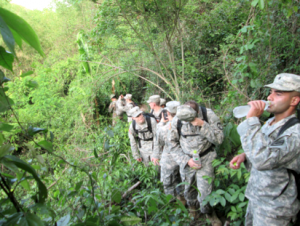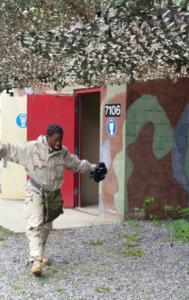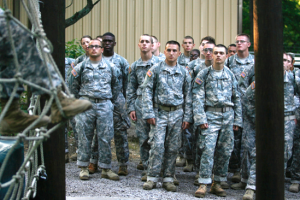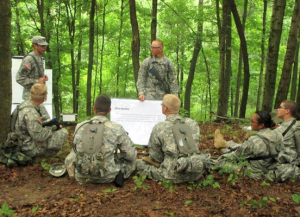In the following essay, Baylor Army ROTC cadet Anthony Rifaat, a senior astrophysics major from Houston, describes what kinds of training cadets take part in during the summer, and what new skills they come away with as a result. A number of photos of summer training follow the essay.
———————————————
Cadet Summer Training
By Cadet Anthony Rifaat
Every summer, after working hard throughout the spring semester, cadets in the Baylor Army ROTC (Reserve Officer Training Corps) program continue to work by attending several different training opportunities offered through the program. These trainings include CULP (Cultural Understanding and Language Proficiency), Air Assault School, LDAC (Leadership Development and Assessment Course) and CTLT (Cadet Troop Leader Training). They provide cadets experience in critical leadership and cultural, social and physical skills to succeed, not just in their future Army career but also in the private workplace.
CTLT, usually conducted after the completion of the third year in ROTC, provides cadets an opportunity to serve in platoon leader positions within active duty units around the world. A unit mentor is assigned to each cadet, and guides them through the nuts and bolts of running an active duty platoon in the Army. CTLT takes place immediately after successfully completing LDAC and lasts about three weeks.
After graduating with the 8th Regiment, Cadet Tara Hutchison traveled to Fort Wainwright, Alaska, where she trained with the 1st Brigade 25th Infantry Division. Among her activities, she completed training for the EIB (Expert Infantry Badge) as well as the EFMB (Expert Field Medic Badge). Hutchison also was able to “shadow a medical service platoon leader, learning the additional responsibilities…that better prepare myself for the future,” as she remarked. The program allows cadets a glimpse of the daily activities of Army life on military installations, which they otherwise would not get until after commissioning.
CULP goes beyond units inside the Army. Cadets travel to different countries throughout Europe, Asia and Africa, and work hand in hand with foreign military units to conduct a variety of missions in the local areas. The missions, which can be humanitarian, educational or military based, immerse cadets in a foreign culture and society, giving them invaluable experiences and memories.
Cadet Clayton Crenshaw, a junior management information systems major, participated in an educational CELTT (Cadet English Language Training Team) mission in Thailand, where cadets instructed high school students in English conversation at the Armed Forces Academy Prep School. The instruction that was provided assisted students preparing to enter one of four Thai service academies.
When not teaching, teams may help run community activities, explore the city or travel throughout the country and visit popular and historical destinations. In his free time and on weekends, Crenshaw explored what not only “Bangkok had to offer” but also “other parts of the country with sites, such as the Bridge on the River Kwai (famous battle of WWII) and historical landmarks that have been around for 500 years.” With so much to see and do, cadets never have enough time but the roughly 21-day trip was “truly an unforgettable experience.”
All the hard work and dedication cadets pour into their first three years in ROTC accumulates at LDAC where thousands of cadets are evaluated on all skills and knowledge learned up to that point. The course, previously located at Fort Lewis, Washington, took place at Fort Knox, Kentucky, for the first time. It was spread out over 13 regiments, from June to August, with each regiment actively engaged for 29 days.
Training events that cadets were evaluated in included First Aid Readiness Training, a confidence course, rappelling, CBRN (Chemical, Biological, Radiological and Nuclear) Training and confidence drill, Land Navigation, and Platoon Operation STX (Situational Training Exercises). Each event brought its own challenges and forced cadets to persevere regardless of any setbacks.
For some, the familiar turned to a new surprise. Martin Kudra, a senior political science major from Chicago, said the confidence obstacle course proved to be a “completely different experience…I wasn’t tethered to anything,” he said. “There were pads for safety but we were pretty high up…I was scared I would fall.” But despite Kudra’s fear of heights, he “pushed past that and found new confidence” in himself.
For others, the new and unexplored trainings were more nerve-racking. “From the time I arrived at Fort Knox”, said Cadet Renae Hagood, a nutrition sciences graduate student, “people kept talking about how daunting the gas chamber would be.” The goal of CBRN training is to build confidence in military equipment, by entering a gas chamber filled with CS (tear) gas and then taking off the protective mask for a few seconds inside. “It was great training that helped me develop confidence in my equipment, so that I may be able to protect myself and my battle buddies in a CBRN combat situation,” Hagood said.
Although LDAC is required, it nevertheless encourages cadets to perform their best on an individual and team level, and hones their overall leadership qualities and expertise.
Though not your typical summer vacation to the Bahamas, cadets enjoyed meaningful, productive, developmental and exciting experiences that shaped their future careers as Army officers. They met challenges and roadblocks with confidence and perseverance. They grew as individual leaders as well, as members of a team. They enhanced their awareness of what it takes to lead an actual platoon.
Most importantly, the cadets expanded their horizon outside the classroom and into the real world. Only the Baylor Army ROTC cadets can say, “I did that during my summer,” here on campus.

Cadet Crenshaw’s team hikes through the hot Thai jungle, exploring far outside the capitol of Bangkok.

Cadet Hagood walks out of the gas chamber after breathing in CS gas. She was instructed to immediately start fanning her arms up and down and continually spit out any chemical residue breathed in.






